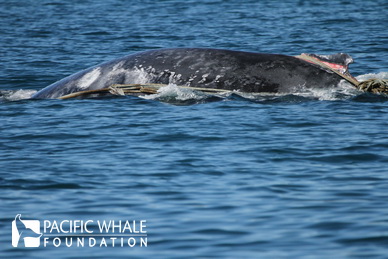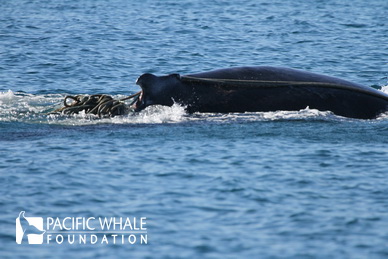When we go on whalewatches, we are entering the world of humpback whales to encounter them in their natural environment. Passengers and crew are often astounded by the diverse behaviors and characteristics of these animals, but occasionally we are also presented with sobering reminders that threats to whales and other marine life are still very real. On one of our recent whalewatches out of Hervey Bay, Australia, all those aboard Ocean Defender were given a glimpse into humpback whale entanglement.
As we entered Platypus Bay we saw our first whale sighting of the day, and the level of excitement was rising. There was a whale swimming by itself, which is not unusual for a humpback whale, but after a few minutes it seemed there may be something wrong. This particular whale was acting stressed and swimming erratically. Then we noticed something odd; as the whale surfaced we could see a laceration on its dorsal fin from dragging several lines.
Since commercial whaling was ended in the 1960s, we have seen the East Australian humpback whale population rise from an estimated 200 – 1,200 humpback whales to over 14,500 whales. Not only that, but they are continuing to increase at a rate of 11% each year. However, the effort to protect these creatures is not over. In Queensland alone, entanglement in shark control gear and fishing gear, as well as other marine debris, accounts for one-third of humpback whale strandings.
This was the first time our passengers and many of the crew had seen an entangled whale. Though government regulations do not allow us to assist with entanglement response, local authorities assessed the situation. They searched for the whale the following day to attempt to help it but, unfortunately, were not able to relocate the animal. The situation created a dynamic disequilibrium; an internal conflict that catches people’s attention and moves them to reassess things. It opened their eyes to the reality that marine conservation is necessary, and that human activities make a very real impact on marine life.
Not everyone can collect marine debris or disentangle a whale, but a significant positive impact can be made by us working together. Small actions like picking up trash on the beach and choosing to recycle, or larger actions like commiting to a plastic free lifestyle or becoming an active part of a local conservation group all add up. Just look at the history of these whales – due to conservation efforts we have already seen enormous recovery in their populations. Our potential impact is limitless.
Please note: if you do come across an entangled whale, do not attempt to assist or free the animal as it is unsafe and illegal unless properly authorized and permitted. Training is highly specialized and requires proper equipment and personnel.


